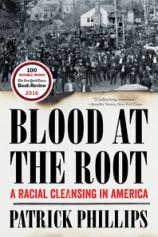Blood at the Root: A Racial Cleansing in America
Review
Blood at the Root: A Racial Cleansing in America
As described by award-winning poet, translator and professor Patrick Phillips, Forsyth County in Georgia was once the site of racial cleansing, when the entire African American population was driven out by terror tactics, never to return.
The post-Civil War era in Forsyth County offers little to admire from the standpoint of treatment of its newly minted citizens, the freed slaves. In common with many areas of the Deep South at that time, the county's menfolk were always prepared to act as a militia to hunt down, torment, torture and kill any person of color who was alleged to have mistreated a white resident. Punishments could be meted out for such “crimes” as protesting against the lynching of a beloved relative, so that once a hanging, beating, burning or torture occurred to one of their own, blacks knew to stay out of sight.
"For those of us who grapple with issues of race in America, BLOOD AT THE ROOT is timely, bringing to our attention an era when the dominant white culture was willing not only to exclude African Americans, but to maim and murder the innocent and those who spoke out."
In 1912, a teenage white girl, Mae Crow, went missing one evening and was later discovered, bloody and beaten, in a weakened condition that led to her death. It didn’t take long to find suspects among the young black men of the county. The first confession, by Ernest Knox, was forced by putting a rope around his neck and threatening to lynch him on the spot. In all, three young men were rounded up; one was killed before the trial that, predictably, found the other two guilty and sentenced them to die. There was no credible evidence to convict any of them. In the course of the white fury that gripped the county, a well-known African American preacher was horsewhipped by an angry mob for daring to speak out against the injustice. Subsequent raids and acts of mayhem throughout the county caused the hasty mass exodus of the black population, many of whom left working farms, houses and possessions to be greedily appropriated by the white marauders.
Having lived in Forsyth County as a young boy, part of a family that held liberal views, Phillips found that returning now to his childhood home took fortitude. Through investigations, interviews and archives, he offers personal histories of the families, both black and white, affected by the events of 1912. He also recounts the two Brotherhood Marches in Forsyth in 1987; the second, widely covered in the American media, was provoked by the shockingly ugly local reaction to the first. Almost 30 years since the marches and more than a hundred years since the cleansing by terror in Forsyth, Phillips uncovered both shame and arrogance, with many residents unwilling to acknowledge their family’s complicity in the events, others seemingly proud to live in what is still one of the “whitest” counties in America.
For those of us who grapple with issues of race in America, BLOOD AT THE ROOT is timely, bringing to our attention an era when the dominant white culture was willing not only to exclude African Americans, but to maim and murder the innocent and those who spoke out.
Reviewed by Barbara Bamberger Scott on September 23, 2016
Blood at the Root: A Racial Cleansing in America
- Publication Date: September 26, 2017
- Genres: History, Nonfiction
- Paperback: 320 pages
- Publisher: W. W. Norton & Company
- ISBN-10: 0393354733
- ISBN-13: 9780393354737











